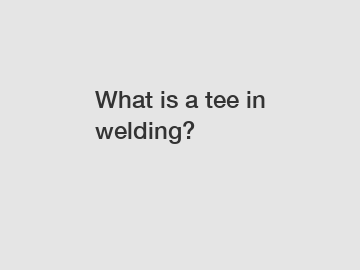What is a tee in welding?
Welding, a vital technique in joining metal parts, encompasses various types and methods. Among these, the tee weld holds immense significance. It is an essential component that enables the creation of strong, durable joints in a variety of applications. In this blog, we will delve into the tee in welding, understanding its purpose, types, and its crucial role in engineering and construction.
Understanding the Tee in Welding.
The tee weld is a type of joint that finds extensive usage in structural frameworks, piping systems, and industrial equipment. As its name implies, it forms a connection shaped like the letter "T". This welding technique allows two perpendicular pieces of metal to be accurately joined, forming a right-angled connection. The resulting joint is sturdy, efficient, and capable of withstanding significant mechanical stresses.

Purpose and Application.
The tee weld serves multiple purposes, primarily offering support, stability, and strength to various structures. This technique is widely employed in construction projects, including bridges, buildings, and pipelines. Its versatility also makes it invaluable in the manufacturing of machinery, heavy equipment, and storage tanks.
Types of Tee Welds.
1. Fillet Tee Weld:
Also known as the partial penetration weld, this type of tee weld joins the vertical member with a horizontal member by creating a triangular-shaped fillet weld along the intersection. It is suitable for applications requiring moderate strength and offers an aesthetically pleasing appearance.
2. Complete Penetration Tee Weld:
Unlike the fillet tee weld, this type ensures complete penetration and fusion along the joint. Achieving this weld requires precise preparation, ensuring a full bond between the intersecting members. It offers exceptional strength and reliability, making it ideal for high-stress applications and heavy-duty structures.
Factors Affecting Tee Weld Quality.
Several factors play a crucial role in determining the quality and longevity of a tee weld. Understanding these factors and adequately addressing them during welding is vital to ensure a robust connection.
1. Proper Joint Preparation:
Careful joint preparation, including cleaning the surface, removing rust and debris, and accurately aligning the components, ensures a strong and durable tee weld. It is essential to follow specific standards and guidelines for preparation to achieve optimal results.
2. Adequate Heat Control:
Regulating the heat input during welding is critical. Excessive temperatures can lead to the distortion of the joint and weaken the overall structure. Conversely, insufficient heat may result in incomplete fusion, reducing joint strength. Skilled welders meticulously manage heat control to strike the perfect balance, ensuring a reliable weld.
3. Welding Technique and Material Selection:
Choosing the appropriate welding technique and selecting the correct filler material are paramount to creating a high-quality tee weld. Different materials require specific techniques and filler metals to achieve optimal penetration and fusion. Employing the right combination enhances weld integrity and strength.
Benefits of Proper Tee Welding.
1. Strength and Durability:
A well-executed tee weld ensures exceptional strength, enabling structures to withstand immense pressure, vibrations, and external forces. This durability translates into increased safety, reduced maintenance, and an extended lifespan for the welded components.
2. Enhanced Structural Integrity:
The tee weld improves the integrity and stability of connections, preventing any relative movement or rotation between the joined members. This rigidity ensures structural soundness, crucial in scenarios where stability is vital, such as high-rise buildings or critical infrastructure projects.
Conclusion.
The tee weld, a fundamental technique in welding, plays a pivotal role in connecting two metal components at a right angle. Its ability to reliably withstand stress and resistance qualifies it as a preferred joint type for various applications. Understanding the different types, factors influencing quality, and the benefits of proper tee welding underscores the need for skilled and knowledgeable welders. By harnessing expertise, experience, and creativity, welders can achieve impeccable tee welds, reinforcing the foundation of structures and equipment that shape our modern world.
If you are looking for more details, kindly visit blank flange manufacturer, carbon steel tees, difference between elbow and bend.

Comments